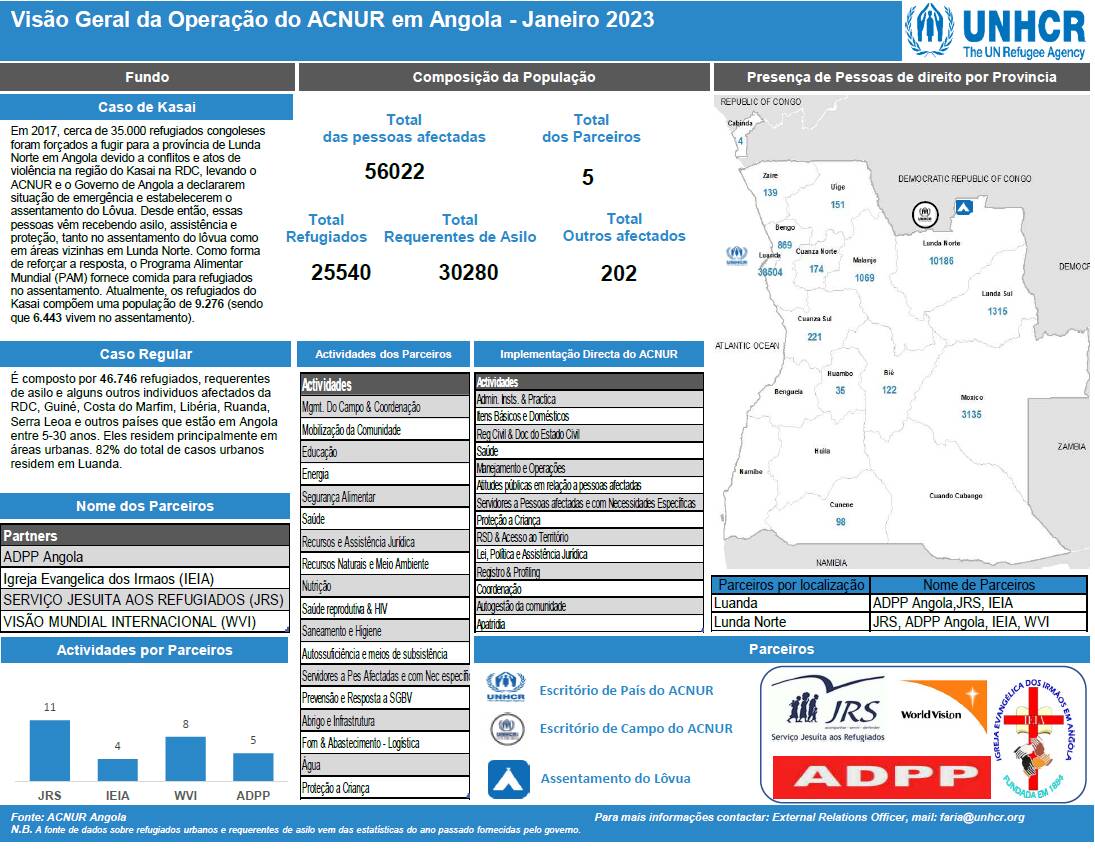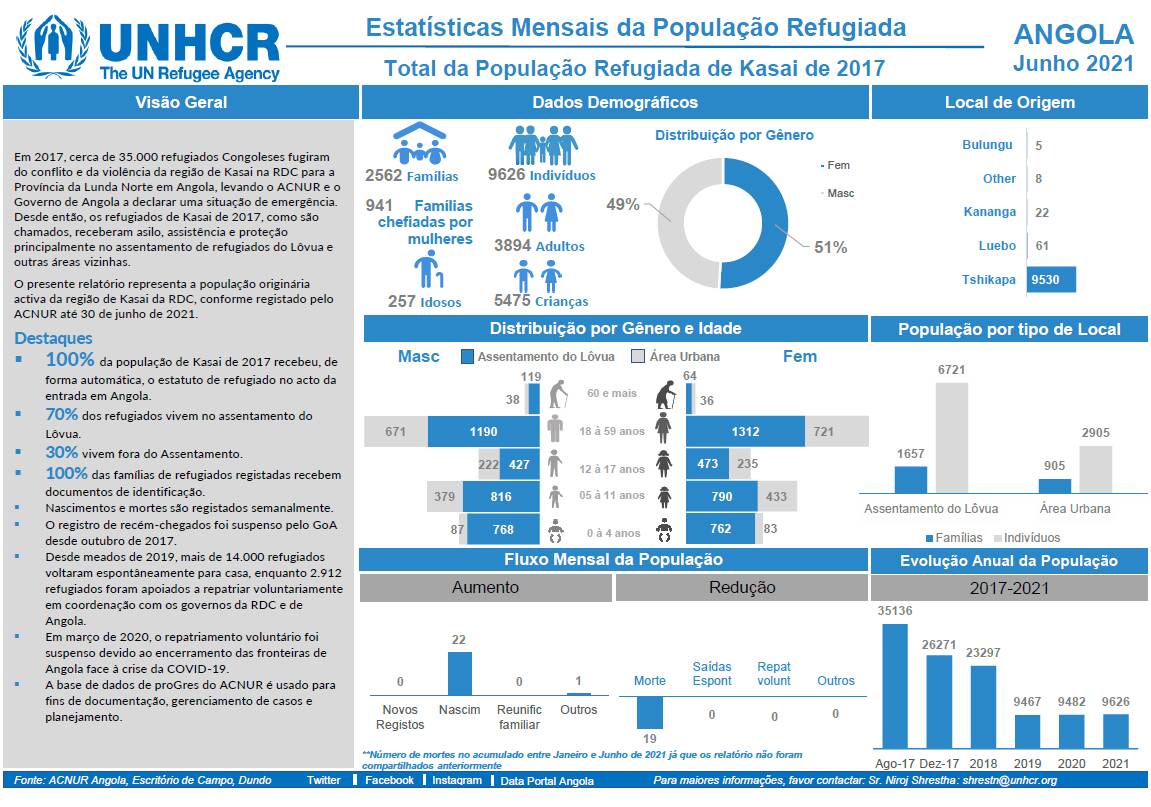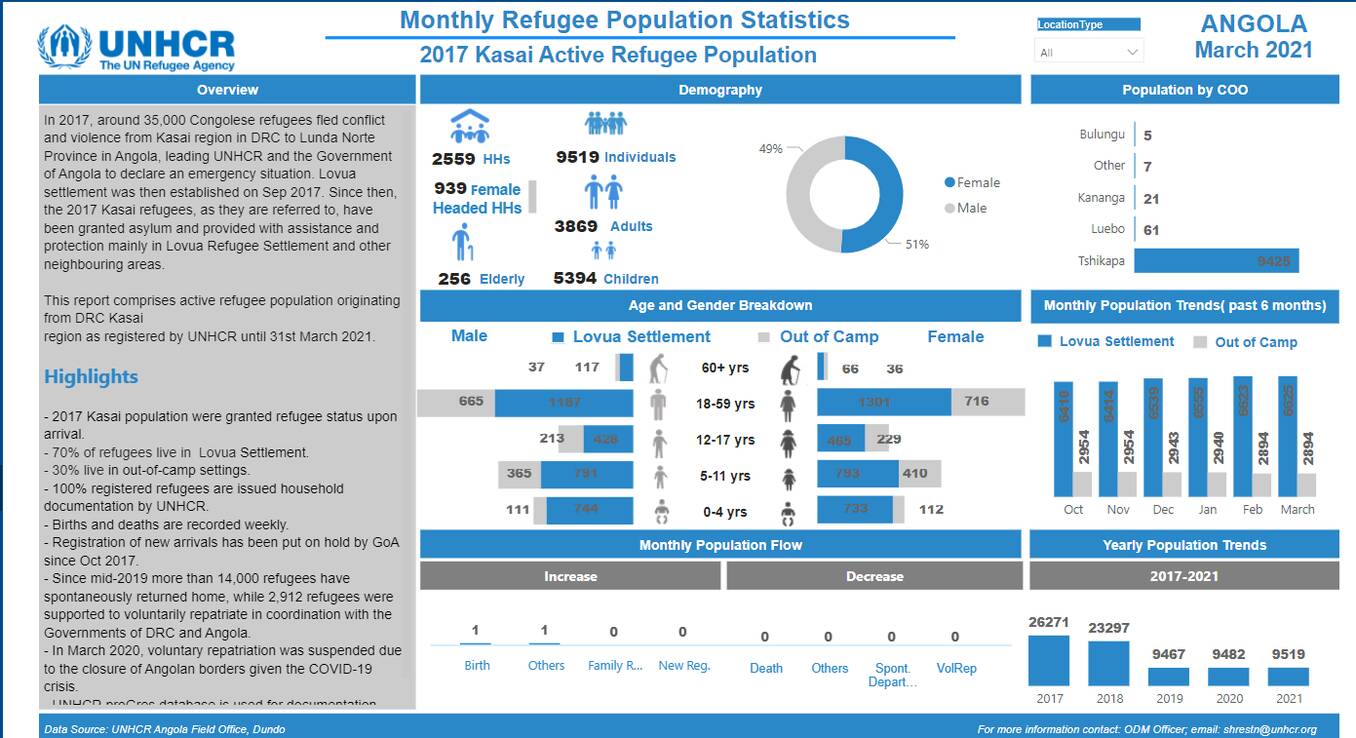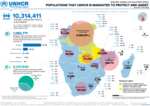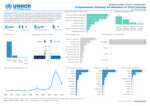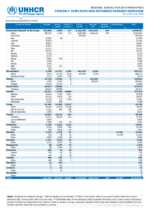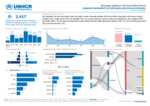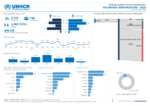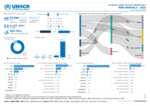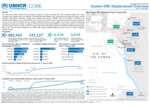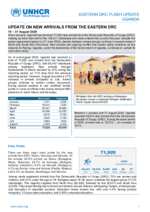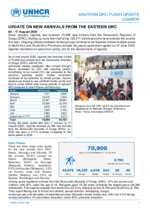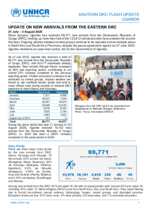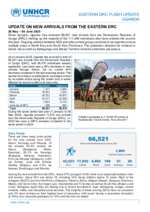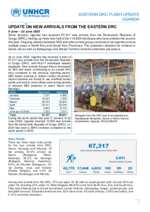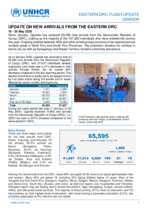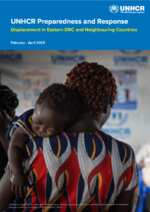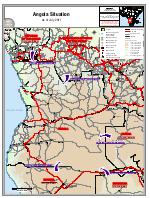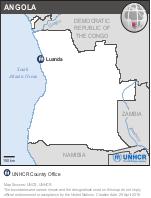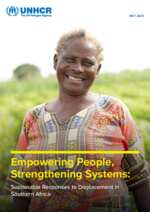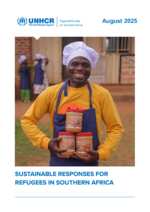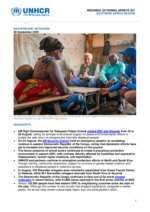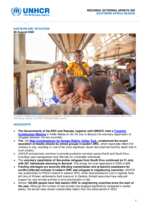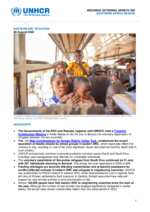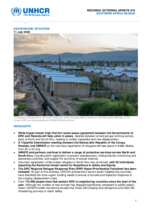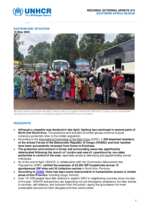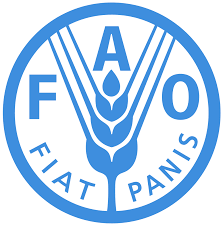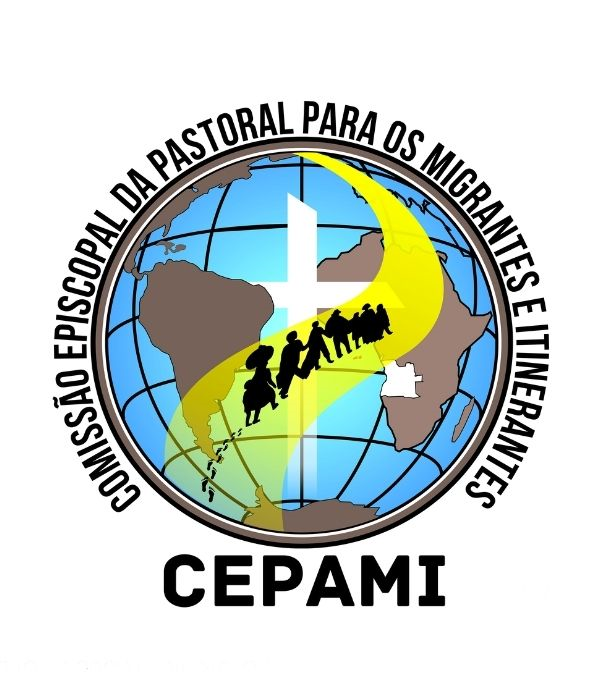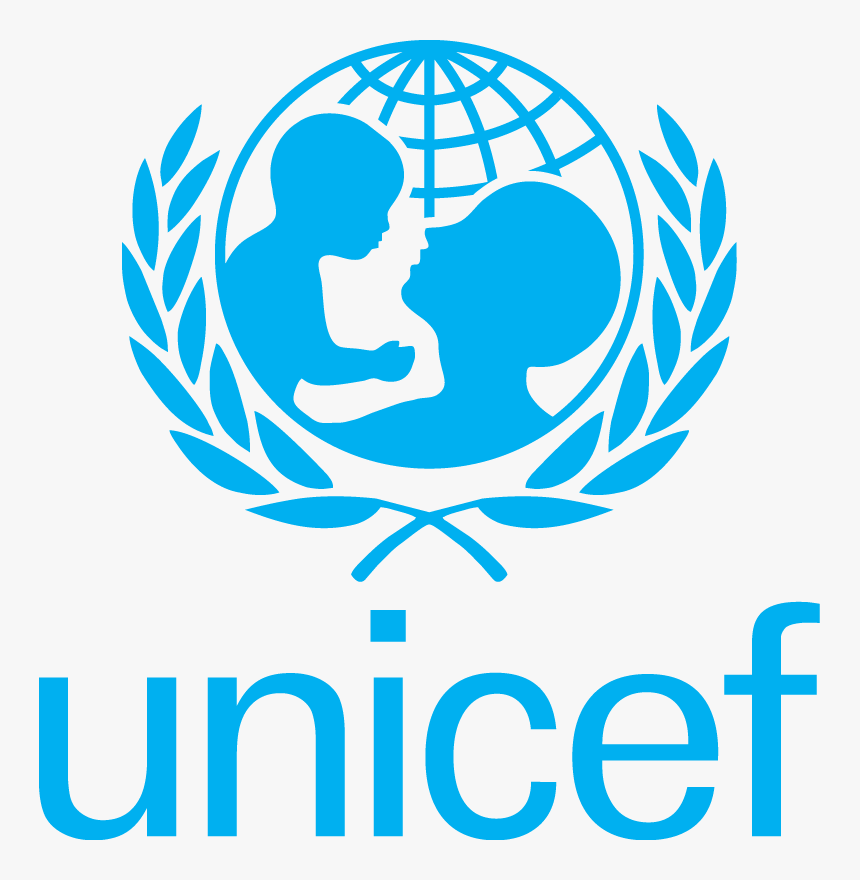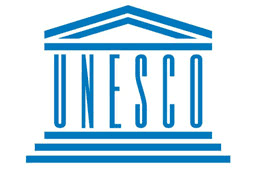| Country of origin | Source | Data date | Population | |
|---|---|---|---|---|
| Dem. Rep. of the Congo | Government, UNHCR | 30 Sep 2025 | 41.4% | 23,077 |
| Guinea | Government, UNHCR | 30 Sep 2025 | 16.6% | 9,272 |
| Côte d'Ivoire | Government, UNHCR | 30 Sep 2025 | 11.4% | 6,357 |
| Mauritania | Government, UNHCR | 30 Sep 2025 | 10.3% | 5,725 |
| Somalia | Government, UNHCR | 30 Sep 2025 | 3.6% | 2,002 |
| Sudan | Government, UNHCR | 30 Sep 2025 | 3.5% | 1,949 |
| Sierra Leone | Government, UNHCR | 30 Sep 2025 | 3.4% | 1,910 |
| Eritrea | Government, UNHCR | 30 Sep 2025 | 3.4% | 1,874 |
| Others | Government, UNHCR | 30 Sep 2025 | 2.4% | 1,323 |
| Chad | Government, UNHCR | 30 Sep 2025 | 1.7% | 968 |
| Liberia | Government, UNHCR | 30 Sep 2025 | 1.1% | 639 |
| Rwanda | Government, UNHCR | 30 Sep 2025 | 1.1% | 626 |
| Location name | Source | Data date | Population | |
|---|---|---|---|---|
| Bengo | Government, UNHCR | 30 Sep 2025 | 1.6% | 869 |
| Bié | Government, UNHCR | 30 Sep 2025 | 0.2% | 122 |
| Cabinda | Government, UNHCR | 30 Sep 2025 | 0.0% | 4 |
| Cuanza Norte | Government, UNHCR | 30 Sep 2025 | 0.3% | 174 |
| Cuanza Sul | Government, UNHCR | 30 Sep 2025 | 0.4% | 221 |
| Cunene | Government, UNHCR | 30 Sep 2025 | 0.2% | 98 |
| Huambo | Government, UNHCR | 30 Sep 2025 | 0.1% | 35 |
| Luanda | Government, UNHCR | 30 Sep 2025 | 68.7% | 38,265 |
| Lunda Norte | Government, UNHCR | 30 Sep 2025 | 18.2% | 10,127 |
| Lunda Sul | Government, UNHCR | 30 Sep 2025 | 2.4% | 1,315 |
| Malanje | Government, UNHCR | 30 Sep 2025 | 1.9% | 1,067 |
| Moxico | Government, UNHCR | 30 Sep 2025 | 5.6% | 3,135 |
| Uíge | Government, UNHCR | 30 Sep 2025 | 0.3% | 151 |
| Zaire | Government, UNHCR | 30 Sep 2025 | 0.2% | 139 |
- All Documents (862)
- 3W (17)
- Assessments (2)
- CORE (16)
- Communication with Communities (3)
- Dashboards & Factsheets (528)
- Data & Statistics (71)
- Flash Update (17)
- Funding (4)
- Guidance (4)
- Maps and geodata (58)
- Population Profiling (1)
- Press Releases (1)
- Regional RRP Documents (7)
- Regional Response Plans (6)
- Reports (30)
- Reports and Assessments (11)
- Situation Reports (35)
- Situation Reports / Updates (106)
- Situation Updates (52)
- Strategy Documents (2)
- Training Materials (1)
- Not categorized (1)
- All Documents (862)
- 3W (17)
- Assessments (2)
- CORE (16)
- Communication with Communities (3)
- Dashboards & Factsheets (528)
- Data & Statistics (71)
- Flash Update (17)
- Funding (4)
- Guidance (4)
- Maps and geodata (58)
- Population Profiling (1)
- Press Releases (1)
- Regional RRP Documents (7)
- Regional Response Plans (6)
- Reports (30)
- Reports and Assessments (11)
- Situation Reports (35)
- Situation Reports / Updates (106)
- Situation Updates (52)
- Strategy Documents (2)
- Training Materials (1)
- Not categorized (1)
Summary of UNHCR’s population in Southern Africa - June 2025
DocumentCreate date: 30 September 2025 (2 months ago)
Overview of complementary pathways statistics in Southern Africa - June 2025
DocumentCreate date: 30 September 2025 (2 months ago)
Comprehensive regional analysis of the UNHCR’s population by asylum country and location - June 2025
DocumentCreate date: 30 September 2025 (2 months ago)
Overview of onward movements in the Southern Africa Region - June 2025
DocumentCreate date: 30 September 2025 (2 months ago)
Overview of Voluntary Repatriation in Southern Africa - June 2025
DocumentCreate date: 30 September 2025 (2 months ago)
Overview of new arrivals in the Southern Africa Region - June 2025
DocumentCreate date: 30 September 2025 (2 months ago)
3Ws Lunda Norte (Angola), 8 July 2019
DocumentCreate date: 12 July 2019 (6 years ago)
3WS Lunda Norte (Angola), 29 May 2019
DocumentCreate date: 29 May 2019 (6 years ago)
3WS Lunda Norte (Angola), 29 April 2019
DocumentCreate date: 3 May 2019 (6 years ago)
3WS Lunda Norte (Angola), 14 February 2019
DocumentCreate date: 21 March 2019 (6 years ago)
3WS Lunda Norte (Angola), 14 January 2018
DocumentCreate date: 15 January 2019 (6 years ago)
3WS Lunda Norte (Angola), 31 October 2018
DocumentCreate date: 5 November 2018 (7 years ago)
Case Study on Statelessness in Angola
DocumentCreate date: 24 February 2023 (2 years ago)
Case Study on Statelessness in Angola - Portuguese
DocumentCreate date: 24 February 2023 (2 years ago)
CORE - Eastern DRC Displacement Overview - 27 March 2025
DocumentCreate date: 28 March 2025 (8 months ago)
CORE - Eastern DRC Displacement Overview - 26 March 2025
DocumentCreate date: 27 March 2025 (8 months ago)
CORE - Eastern DRC Displacement Overview - 24 March 2025
DocumentCreate date: 26 March 2025 (8 months ago)
CORE - Eastern DRC Displacement Overview - 20 March 2025
DocumentCreate date: 21 March 2025 (9 months ago)
CORE - Eastern DRC Situation Overview - 13 May 2025
DocumentCreate date: 15 May 2025 (7 months ago)
CORE - Eastern DRC Displacement Overview - 19 March 2025
DocumentCreate date: 20 March 2025 (9 months ago)
O Papel da Comunicação na Protecção dos Refugiados
DocumentCreate date: 28 March 2018 (7 years ago)
Creating Community Leadership Structures in Lovua Settlement - draft concept note 17 September
DocumentCreate date: 18 September 2017 (8 years ago)
Focus Group Discussion Report: Relocation of Congolese refugees in Lunda Norte, Angola
DocumentCreate date: 22 July 2017 (8 years ago)
Summary of UNHCR’s population in Southern Africa - June 2025
DocumentCreate date: 30 September 2025 (2 months ago)
Overview of complementary pathways statistics in Southern Africa - June 2025
DocumentCreate date: 30 September 2025 (2 months ago)
Comprehensive regional analysis of the UNHCR’s population by asylum country and location - June 2025
DocumentCreate date: 30 September 2025 (2 months ago)
Overview of onward movements in the Southern Africa Region - June 2025
DocumentCreate date: 30 September 2025 (2 months ago)
Overview of Voluntary Repatriation in Southern Africa - June 2025
DocumentCreate date: 30 September 2025 (2 months ago)
Overview of new arrivals in the Southern Africa Region - June 2025
DocumentCreate date: 30 September 2025 (2 months ago)
Annual Statistics Report-2020
DocumentCreate date: 14 April 2021 (4 years ago)
Angola to DRC Voluntary Repatriation Information & Figures
DocumentCreate date: 29 March 2020 (5 years ago)
Weekly Statistics - DRC Refugees in Lunda Norte, Angola (23 March 2020)
DocumentCreate date: 29 March 2020 (5 years ago)
Weekly Statistics - DRC Refugees in Lunda Norte, Angola (26 February 2020)
DocumentCreate date: 27 February 2020 (5 years ago)
Weekly Statistics - DRC Refugees in Lunda Norte, Angola (13 February 2020)
DocumentCreate date: 23 February 2020 (5 years ago)
Weekly Statistics - DRC Refugees in Lunda Norte, Angola (3 February 2020)
DocumentCreate date: 23 February 2020 (5 years ago)
DRC Flash update - 18 - 31 August 2025
DocumentCreate date: 12 September 2025 (3 months ago)
DRC Flash update - 04 - 17 August 2025
DocumentCreate date: 22 August 2025 (3 months ago)
DRC Flash update - 21 July - 3 August 2025
DocumentCreate date: 7 August 2025 (4 months ago)
DRC Flash update - 26 May - 8 June 2025
DocumentCreate date: 7 August 2025 (4 months ago)
DRC Flash update - 9 - 22 June 2025
DocumentCreate date: 7 August 2025 (4 months ago)
DRC Flash update - 19 - 25 May 2025
DocumentCreate date: 29 May 2025 (6 months ago)
UNHCR Preparedness and Response - Displacement in Eastern DRC and Neighbouring Countries - February 2025
DocumentCreate date: 22 February 2025 (9 months ago)
Angola Inter-Agency Refugee Appeal , January - December 2018
DocumentCreate date: 28 March 2018 (7 years ago)
Apelo Inter-Agências para os Refugiados em Angola
DocumentCreate date: 3 July 2017 (8 years ago)
Angola Inter-Agency Refugee Appeal April December 2017
DocumentCreate date: 15 June 2017 (8 years ago)
Angola Emergency Response: Expression of Interest I/NGOs
DocumentCreate date: 25 May 2017 (8 years ago)
Angola Emergency Response: Expression of Interest I/NGOs
DocumentCreate date: 25 May 2017 (8 years ago)
RCM - Modelo de Coordenação de Refugiados do ACNUR
DocumentCreate date: 19 May 2017 (8 years ago)
UNHCR Refugee Coordination Model
DocumentCreate date: 19 May 2017 (8 years ago)
Southern Africa Region - Persons of Concern - as of mid-2018
DocumentCreate date: 25 September 2018 (7 years ago)
Angola - July 2011
DocumentCreate date: 18 July 2011 (14 years ago)
Angola Situation - July 2011
DocumentCreate date: 18 July 2011 (14 years ago)
Southern Africa Region - Persons of Concern - as of mid-2018
DocumentCreate date: 5 December 2018 (7 years ago)
Angola Emergency - Outflow of Congolese refugees from the Kasai region - 18 April 2017
DocumentCreate date: 4 May 2017 (8 years ago)
Angola - Inset Map - 29 April 2016
DocumentCreate date: 10 January 2017 (8 years ago)
June Regional Population Data Analysis for Southern Africa - June 2024
DocumentCreate date: 20 February 2025 (10 months ago)
RCO & UNHCR Press Release - Organized Repatriation Angola
DocumentCreate date: 14 November 2019 (6 years ago)
Democratic Republic of the Congo Regional Refugee Response Plan Dashboard - September 2023
DocumentCreate date: 21 December 2023 (2 years ago)
Democratic Republic of the Congo Regional Refugee Response Plan Dashboard - June 2023
DocumentCreate date: 14 August 2023 (2 years ago)
Democratic Republic of the Congo Regional Refugee Response Plan Dashboard - April 2023
DocumentCreate date: 14 July 2023 (2 years ago)
Democratic Republic of the Congo Refugees Situation Dashboard - June 2023
DocumentCreate date: 14 July 2023 (2 years ago)
Summary - The Democratic Republic of the Congo Regional Refugee Response Plan (RRRP) 2020-2021
DocumentCreate date: 6 March 2020 (5 years ago)
DRC 2019-2020 RRRP At A Glance - en
DocumentCreate date: 12 December 2018 (7 years ago)
UNHCR Preparedness and Response - Displacement in Eastern DRC and Neighbouring Countries - February 2025
DocumentCreate date: 22 February 2025 (9 months ago)
The Democratic Republic of the Congo Regional Refugee Response Plan (RRRP) 2020-2021
DocumentCreate date: 5 March 2020 (5 years ago)
The Democratic Republic of Congo Regional Refugee Response Plan (RRRP) 2019-2020 - Revised in June 2019
DocumentCreate date: 30 June 2019 (6 years ago)
UNHCR-UNDP Joint Programming Initiatives for the DRC situation
DocumentCreate date: 16 January 2019 (6 years ago)
The Democratic Republic of Congo Regional Refugee Response Plan (RRRP) 2019-2020
DocumentCreate date: 11 December 2018 (7 years ago)
Democratic Republic of Congo Regional Refugee Response Plan (RRRP) 2018 - Revised in May 2018
DocumentCreate date: 17 July 2018 (7 years ago)
UNHCR Report - Empowering People, Strengthening Digital Systems
DocumentCreate date: 19 June 2025 (6 months ago)
Angola Monthly Population Statistics_TotalKasai_Popn_February_2024
DocumentCreate date: 4 March 2024 (1 year ago)
Angola Monthly Population Statistics_Camp_Kasai_Popn_February_2024
DocumentCreate date: 4 March 2024 (1 year ago)
Angola Monthly Population Statistics_TotalKasai_Popn_February_2024-Portuguese
DocumentCreate date: 4 March 2024 (1 year ago)
Angola Monthly Population Statistics_Camp_Kasai_Popn February_2024-Portuguese
DocumentCreate date: 4 March 2024 (1 year ago)
Participatory Assessment Report 2021
DocumentCreate date: 8 August 2022 (3 years ago)
Sustainable Responses for Refugees in SOUTHERN AFRICA - Aug 2025
DocumentCreate date: 4 September 2025 (3 months ago)
MMC WEST AFRICA - 4Mi Snapshot - October 2018
DocumentCreate date: 14 November 2018 (7 years ago)
Angola - SEXUAL AND GENDER BASED VIOLENCE TRENDS ANALYSIS (1-30 Jan 2018), Lunda Norte
DocumentCreate date: 5 March 2018 (7 years ago)
Protection weekly report 11 - 16 September / Protecção relatório semanal 11 - 16 Setembro
DocumentCreate date: 23 September 2017 (8 years ago)
Criando Estruturas de Liderança Comunitária no Assentamento de Lovúa Grupo de Trabalho de Protecção
DocumentCreate date: 20 September 2017 (8 years ago)
HESPER Survey Results - September 2017
DocumentCreate date: 16 September 2017 (8 years ago)
DRC Refugees Situation Dashboard - 28 February 2025
DocumentCreate date: 7 April 2025 (8 months ago)
Eastern DRC Situation - Regional External Update #9 - 28 March 2025
DocumentCreate date: 29 March 2025 (8 months ago)
CORE - Eastern DRC Displacement Overview - 27 March 2025
DocumentCreate date: 28 March 2025 (8 months ago)
CORE - Eastern DRC Displacement Overview - 26 March 2025
DocumentCreate date: 27 March 2025 (8 months ago)
CORE - Eastern DRC Displacement Overview - 24 March 2025
DocumentCreate date: 26 March 2025 (8 months ago)
CORE - Eastern DRC Displacement Overview - 20 March 2025
DocumentCreate date: 21 March 2025 (9 months ago)
DRC Situation External Update #21 - 8-Sep-2025
DocumentCreate date: 29 September 2025 (2 months ago)
DRC Situation External Update #20 - 8-Aug-2025
DocumentCreate date: 12 August 2025 (4 months ago)
DRC Situation External Update #20 - 8-Aug-2025
DocumentCreate date: 12 August 2025 (4 months ago)
DRC Situation External Update #19 - 11 Jun 2025
DocumentCreate date: 14 July 2025 (5 months ago)
DRC Situation External Update #16 - 29 May 2025
DocumentCreate date: 30 May 2025 (6 months ago)
DRC Situation External Update #15 - 16/05/2025
DocumentCreate date: 19 May 2025 (7 months ago)
DRC Flash update - 18 - 31 August 2025
DocumentCreate date: 12 September 2025 (3 months ago)
DRC Flash update - 04 - 17 August 2025
DocumentCreate date: 22 August 2025 (3 months ago)
DRC Flash update - 21 July - 3 August 2025
DocumentCreate date: 7 August 2025 (4 months ago)
DRC Flash update - 26 May - 8 June 2025
DocumentCreate date: 7 August 2025 (4 months ago)
DRC Flash update - 9 - 22 June 2025
DocumentCreate date: 7 August 2025 (4 months ago)
DRC Flash update - 19 - 25 May 2025
DocumentCreate date: 29 May 2025 (6 months ago)
UNHCR and WFP Angola Joint Livelihood Strategy
DocumentCreate date: 29 May 2019 (6 years ago)
Lunda Norte Shelter Strategy (2018)
DocumentCreate date: 19 July 2019 (6 years ago)
EXTENSAO da data limite para entrega de candidaturas, 17 de Novembro! Chamada à participação - Curso sobre apatridia e o direito à nacionali...
DocumentCreate date: 24 October 2017 (8 years ago)
End of Year Report for the 2018 Regional Refugee Response Plan (RRRP) for the Democratic Republic of Congo (DRC) situation
DocumentCreate date: 30 April 2019 (6 years ago)
JSON
-
Case Study on Statelessness in Angola - Portuguese
Study on the risk of statelessness in Angola and for Angolans staying abroad. Jointly launched with Government of Angola(Min. of Justice and Human Rights)Publish date: 24 February 2023
-
Case Study on Statelessness in Angola
Study on the risk of statelessness in Angola and for Angolans staying abroad. Jointly launched with Government of Angola(Min. of Justice and Human Rights)Publish date: 24 February 2023
-
Angola - DRC Situation
The on-going conflicts in the Democratic Republic of the Congo (DRC) have caused and continue to cause internal and external displacement of populations. In 2017, some 100,000 Congolese fled to neighbouring countries as refugees, due to widespread militia activities, unrest and violence, joining the 585,000 already in exile. The security conditions in DRC, especially in the eastern and central parts have continued to worsen since the beginning of 2018. Because of this, the Congolese refugee population is now among the ten largest in the world. Nearly 55 per cent are children, many crossing borders unaccompanied or separated. Existing camps and sites in many asylum countries are saturated, and available basic services are stretched to the limit. The situation requires support, adequate resources and collaboration so that effective protection and assistance can be delivered efficiently to Congolese refugees.
-
Angola - Eradication of Statelessness in the East and Horn of Africa, and the Great Lakes Region
Highlighting statelessness in the 12 Member States of the ICGLR, and what is being done to eradicate it. Media coverage, testimonies of stateless persons, reports on the issue and all documents pertaining to the Brazzaville Declaration process can be consulted in English, French, Portuguese and Arabic.
-
Angola - Regional Bureau for Eastern and Southern Africa
UNHCR Regional Bureau for Eastern and Southern Africa (RBESA) is based in Nairobi, Kenya, covering 25 countries. This includes Angola, Botswana, Burundi, Comoros, Djibouti, Eritrea, Eswatini, Ethiopia, Kenya, Lesotho, Madagascar, Malawi, Mauritius, Mozambique, Namibia, Rwanda, Seychelles, Somalia, South Africa, South Sudan, Sudan, Tanzania, Uganda, Zambia, and Zimbabwe. This follows UNHCR’s restructuring in October 2025, merging countries previously under the East, Horn of Africa, and Great Lakes (EHAGL) and Southern Africa (SA) regional bureaus. In addition to the bureau, there are three Multi-Country Offices (MCO), Mozambique MCO that will be covering Mozambique and Angola, and Zambia MCO that will be covering Malawi, Zambia and Zimbabwe and South Africa MCO covering Botswana, Comoros, Eswatini, Lesotho, Madagascar, Mauritius, Namibia, Seychelles and South Africa. The bureau also manages two specific situations: the Sudan Situation and the South Sudan Situation. It is responsible for strategic decisions, regional priorities, integrity oversight, and quality assurance. The RBESA also provides technical support to country operations in various sectors, including education, child protection, economic inclusion, and durable solutions.
| Angola Regular Caseload | It comprises of 46,707 refugees, asylum-seekers and few others of concern from DRC, Guinea, Ivory Coast, Liberia, Rwanda, Sierra Leone and other countries who has been in Angola between 5-30 years. They are residing mostly in urban location. 82% of the total urban caseload reside in Luanda. |
|---|
| Angola DRC Kasai Caseload | In 2017, around 35,000 Congolese refugees fled conflict and violence from Kasai region in DRC to Lunda Norte Province in Angola, leading UNHCR and the Government of Angola to declare an emergency situation. Lovua settlement was then established on Sep 2017. Since then, the 2017 Kasai refugees whose current population is 9,217 (6,406 resides in Lovua settlement), as they are referred to, have been granted asylum and provided with assistance and protection mainly in Lovua Refugee Settlement and other neighbouring areas within Lunda Norte. WFP provides food to refugees residing in settlement. |
Please contact the following focal points:
| Title | Contact |
|---|---|
| UNHCR Angola Representative | Emmanuelle Nathalie Mitte mitte@unhcr.org |
| External Relations / Reporting Officer | Camila Geraldo ignaciog@unhcr.org |
